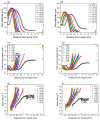Bamboo Charcoal/Poly(L-lactide) Fiber Webs Prepared Using Laser-Heated Melt Electrospinning
- PMID: 34451314
- PMCID: PMC8401290
- DOI: 10.3390/polym13162776
Bamboo Charcoal/Poly(L-lactide) Fiber Webs Prepared Using Laser-Heated Melt Electrospinning
Abstract
Although several studies have reported that the addition of bamboo charcoal (BC) to polylactide (PLA) enhances the properties of PLA, to date, no study has been reported on the fabrication of ultrafine BC/poly(L-lactide) (PLLA) webs via electrospinning. Therefore, ultrafine fiber webs of PLLA and BC/PLLA were prepared using PLLA and BC/PLLA raw fibers via a novel laser electrospinning method. Ultrafine PLLA and BC/PLLA fibers with average diameters of approximately 1 μm and coefficients of variation of 13-23 and 20-46% were obtained. Via wide-angle X-ray diffraction (WAXD) analysis, highly oriented crystals were detected in the raw fibers; however, WAXD patterns of both PLLA and BC/PLLA webs implied an amorphous structure of PLLA. Polarizing microscopy images revealed that the webs comprised ultrafine fibers with uniform diameters and wide variations in birefringence. Temperature-modulated differential scanning calorimetry measurements indicated that the degree of order of the crystals in the fibers was lower and the molecules in the fibers had higher mobilities than those in the raw fibers. Transmittance of BC/PLLA webs with an area density of 2.6 mg/cm2 suggested that the addition of BC improved UV-shielding efficiencies.
Keywords: UV shielding; bamboo charcoal; carbon dioxide laser; melt-electrospinning; polylactide; ultrafine fibers.
Conflict of interest statement
The authors declare no conflict of interest.
Figures
















Similar articles
-
Planar or Biaxial Stretching of Poly(ethylene terephthalate) Fiber Webs Prepared by Laser-Electrospinning.Materials (Basel). 2022 Mar 17;15(6):2209. doi: 10.3390/ma15062209. Materials (Basel). 2022. PMID: 35329660 Free PMC article.
-
Structure and Properties of Poly(ethylene terephthalate) Fiber Webs Prepared via Laser-Electrospinning and Subsequent Annealing Processes.Materials (Basel). 2020 Dec 18;13(24):5783. doi: 10.3390/ma13245783. Materials (Basel). 2020. PMID: 33352872 Free PMC article.
-
Structure Mediation and Properties of Poly(l-lactide)/Poly(d-lactide) Blend Fibers.Polymers (Basel). 2018 Dec 6;10(12):1353. doi: 10.3390/polym10121353. Polymers (Basel). 2018. PMID: 30961279 Free PMC article.
-
Homocrystallization and Stereocomplex Crystallization Behaviors of As-Spun and Hot-Drawn Poly(l-lactide)/Poly(d-lactide) Blended Fibers During Heating.Polymers (Basel). 2019 Sep 14;11(9):1502. doi: 10.3390/polym11091502. Polymers (Basel). 2019. PMID: 31540132 Free PMC article.
-
Syntheses and physical characterization of new aliphatic triblock poly(L-lactide-b-butylene succinate-b-L-lactide)s bearing soft and hard biodegradable building blocks.Biomacromolecules. 2003 Nov-Dec;4(6):1827-34. doi: 10.1021/bm034235p. Biomacromolecules. 2003. PMID: 14606915
Cited by
-
PCL/Collagen/UA Composite Biomedical Dressing with Ordered Microfiberous Structure Fabricated by a 3D Near-Field Electrospinning Process.Polymers (Basel). 2022 Dec 31;15(1):223. doi: 10.3390/polym15010223. Polymers (Basel). 2022. PMID: 36616572 Free PMC article.
-
Data Glove with Self-Compensation Mechanism Based on High-Sensitive Elastic Fiber-Optic Sensor.Polymers (Basel). 2022 Dec 26;15(1):100. doi: 10.3390/polym15010100. Polymers (Basel). 2022. PMID: 36616450 Free PMC article.
-
Activated Carbon-Enriched Electrospun-Produced Scaffolds for Drug Delivery/Release in Biological Systems.Int J Mol Sci. 2023 Apr 4;24(7):6713. doi: 10.3390/ijms24076713. Int J Mol Sci. 2023. PMID: 37047685 Free PMC article.
-
Planar or Biaxial Stretching of Poly(ethylene terephthalate) Fiber Webs Prepared by Laser-Electrospinning.Materials (Basel). 2022 Mar 17;15(6):2209. doi: 10.3390/ma15062209. Materials (Basel). 2022. PMID: 35329660 Free PMC article.
-
Laser-Assisted Melt Electrospinning of Poly(L-lactide-co-ε-caprolactone): Analyses on Processing Behavior and Characteristics of Prepared Fibers.Polymers (Basel). 2022 Jun 20;14(12):2511. doi: 10.3390/polym14122511. Polymers (Basel). 2022. PMID: 35746087 Free PMC article.
References
-
- Park J.H., Rutledge G.C. Ultrafine high performance polyethylene fibers. J. Mater. Sci. 2018;53:3049–3063. doi: 10.1007/s10853-017-1724-z. - DOI
-
- Yu Y., Xiong S., Huang H., Zhao L., Nie K., Chen S., Xu J., Yin X., Wang H., Wang L. Fabrication and application of poly (phenylene sulfide) ultrafine fiber. React. Funct. Polym. 2020;150:104539. doi: 10.1016/j.reactfunctpolym.2020.104539. - DOI
-
- Iordanskii A., Karpova S., Olkhov A., Borovikov P., Kildeeva N., Liu Y. Structure-morphology impact upon segmental dynamics and diffusion in the biodegradable ultrafine fibers of polyhydroxybutyrate-polylactide blends. Eur. Polym. J. 2019;117:208–216. doi: 10.1016/j.eurpolymj.2019.05.012. - DOI
Grants and funding
LinkOut - more resources
Full Text Sources

